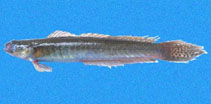| Family: |
Gobiidae (Gobies), subfamily: Gobionellinae |
| Max. size: |
14.3 cm SL (male/unsexed); 8.12 cm SL (female) |
| Environment: |
demersal; marine |
| Distribution: |
Eastern Central Pacific: El Salvador to Panama and possibly Ecuador. |
| Diagnosis: |
Dorsal spines (total): 6-6; Dorsal soft rays (total): 15-16; Anal spines: 1-1; Anal soft rays: 15-15. This species differs from its congeners by the following characters: terminal mouth oblique; absence of a large blotch on pectoral-fin base; trunk with a large blotch anterodorsally beneath pectoral fin and a series of small midlateral spots, but no series of large midlateral blotches with vertical extensions; D2 and A each with 15 elements; broadly confluent dorsal fins; small cycloid scales completely covering trunk and nape, with 70 or more in a lateral series; upper jaw with one complete row of teeth in most specimens, but 2 or 3 appearing in larger individuals; first gill arch with 8 thin rakers on ceratobranchial, 6 on epibranchial (Ref. 55435). |
| Biology: |
Collected from tidepools, over sand and mud bottoms (Ref. 55435). |
| IUCN Red List Status: |
Data deficient (DD); Date assessed: 23 May 2007 Ref. (130435)
|
| Threat to humans: |
harmless |
Source and more info: www.fishbase.org. For personal, classroom, and other internal use only. Not for publication.

